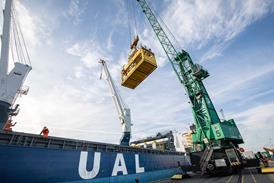September 4 - Rotterdam headquartered ShoreTension has developed a dynamic mooring system that promotes the safer mooring of sea-going vessels while in port.
According to Martijn Breuer, managing director at ShoreTension, the system significantly reduces movement caused by strong winds, currents, swell or passing ships.
When using traditional mooring lines movement is always present, he highlighted. "In extreme conditions, the tremendous pressure this exerts on the ship can cause the mooring lines to snap with potentially serious consequences … The ShoreTension system mitigates this risk significantly. Ships are moored to the quay much sturdier and therefore much safer."
In action
The cylindrical ShoreTension system exerts a constant pressure to the ship's mooring lines, which are fastened to bollards on the quay. "This requires no electricity except for an external hydraulic system that only needs to be used once to get the system at the correct tension. After that, the cylinder of the ShoreTension hydraulically moves along with the forces that the mooring line is exposed to," Breuer explained.
"The ShoreTension provides a high tension and pays out the line, coping with the peak loads without exceeding the minimum breaking load (MBL) of the line," he continued. "By doing this, the system dampens the ship's motion and absorbs the energy of the ship. When the peak loads are over, the ShoreTension heaves in the line with the energy stored and returns to its initial position."
For additional security, the ShoreTension is used in combination with a high-quality mooring line made of HMPE, a super-strong synthetic fibre developed by DSM Dyneema. Moreover, the system is carbon neutral, as is does not require an external energy source.
Breuer highlighted that the systems allows terminals to operate more efficiently; ships are moored alongside the quay with greater stability, promoting unhindered operations and reducing the risk of damage during the loading and discharge of cargoes.
The ShoreTension system has already been used on ultra large container vessels, bulk carriers, tankers, cruise ships and many heavy transport operations.

















